That zippy, slightly lemony flavour or parsley, with a touch of carrot thrown in for good measure, is super easy to achieve in pots at home. If you’ve ever considered growing herbs but stopped yourself for lack of space, or know-how, let us help you through this guide to growing parsley.
You can grow parsley in the smallest of spaces, and with a few unique varieties to choose from, there’s very little that can get in your way. In this guide, we’ve got everything from propagation tips to pest control, so growing your own parsley should be a no-brainer in future.
More...

Family: | Apiaceae |
|---|---|
Genus: | Petroselinum |
Species: | crispum |
Common Names: | Parsley |
Location: | Indoor or outdoor |
Type: | Herb |
Growth: | 30cm x 30cm |
Sun requirements: | Full sun or dappled shade |
Foliage Colour: | Green |
Flower Colour: | White |
Flowering: | Summer (year-round indoors) |
Fruit: | None, edible seeds |
Maintenance level: | Medium |
Poisonous for pets: | Some varieties are toxic (Curly leaf parsley is safe) |
What is Parsley?

Parsley is a tough little plant in the carrot family, with surprisingly hardy roots, and plenty of flavourful herbaceous top growth. As well as its leaves, you can use the seeds to add flavour to sauces and soups, and the stems make a great addition to stocks.
Technically, parsley is a biennial, but like all biennial plants, that refers to its flower and seed production, which occurs in the second year after sowing. In terms of culinary uses, you can grow ready-to-eat parsley in less than a month!
Parsley’s Natural Habitat
Like so many of the herbs we love in the kitchen, parsley is a Mediterranean herb, and used to dry soils, but has spread throughout Europe, where it can be found growing in many forms, with dozens of species to choose from.
The most basic form of Parsley, Petroselinum crispum, or flat leaf parsley, can be grown on any soil, from clay to sand, but prefers good drainage, and regular watering. Its roots are slow growing, so it’s suitable for terracotta containers, which help to mimic its natural habitat.
Best Types of Parsley to Grow in Australia
1. Flat Leaf Parsley (Petroselinum crispum)
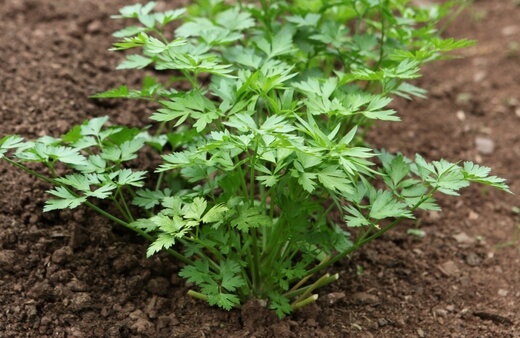
Common parsley, or flat leaf parsley is the most readily available parsley in grocery stores, either dried or fresh, and also the easiest variety to find as seeds for growing at home. The distinctive flavour of flat leaf parsley is hard to replicate, but (as we’ll see below) can be replaced with parsnip leaves or carrot leaves in some dishes.
Flat leaf parsley is the base standard of the species Petroselinum crispum, which forms the base species of most common cultivars.
2. Curly Leaf Parsley (Petroselinum crispum var. neapolitanum)

Curly leaf parsley, Petroselinum crispum var. neapolitanum, is much easier to grow at home, and far more resilient to damp conditions if you struggle to provide good drainage. Its leaves are tougher and thicker than flat leaf parsley, and their crinkled appearance translates to a slow flavour, that breaks down more evenly in salads, or as a garnish.
Curly leaf parsley is also great for grilled dishes, tossed in olive oil to prevent burning.
3. Corn Parsley (Petroselinum segetum)
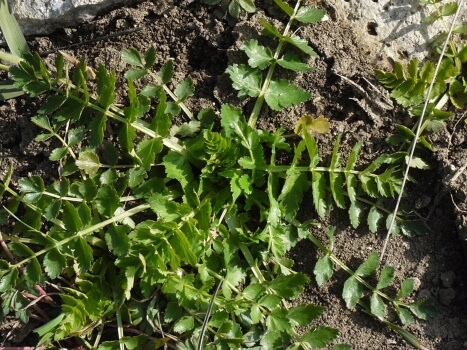
Source: Wikimedia Commons
Petroselinum segetum has a more delicate flavour, but really comes into its own in the garden. At 1 m tall, with a spread of 50-75 cm, this tough herb is just as useful as a border plant as it is in the kitchen.
One brief word of warning though, don’t try to grow corn parsley indoors; 1) it’s too big; 2) it can self-seed without soil, so you might end up with parsley growing up behind the counter…
4. Hamburg Parsley (Petroselinum crispum var. tuberosum)
Hamburg parsley is perhaps the most useful parsley for small gardens as it doubles up as a delicious root vegetable, which looks like parsnip but tastes halfway between that and carrot, with a hint of parsley leaf-flavour in the root too.
The leaves can be harvested throughout the year, but make sure to leave at least 2/3 of the top growth on the plant to support developing roots.
5. Japanese Parsley (Cryptotaenia japonica)
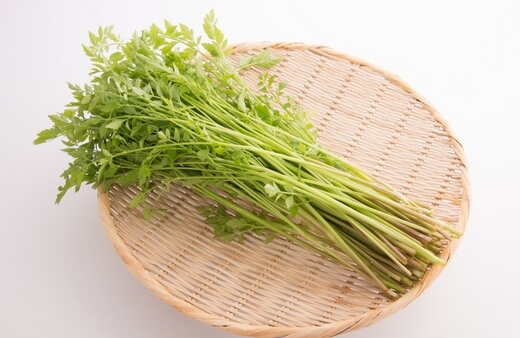
Japanese parsley isn’t actually a parsley, but it has a similar appearance, and close flavour to common parsley. Mitsuba is a year-round salad crop, which can grow outdoors in most of Australia at any time of year.
Mitsuba, or Japanese parsley, is also a great option for shady gardens, as it will tolerate part shade, and as little as 3 hours of direct light per day, provided the garden is generally bright and ventilated.
How to Grow Parsley in Australia
Growing parsley at home couldn’t be simpler. Just get some half-decent compost and fill any container you have on hand (literally… even old milk cartons will work). Parsley grows best outdoors in Australia, in full sun, but with some protection from the baking afternoon sun in the summer.
However, it’s a great windowsill herb, and works as a cut-and-come-again crop in most homes, just be sure to manage its moisture levels, and Parsley can be quite a hungry plant once you start harvesting.
Growing Parsley Outdoors
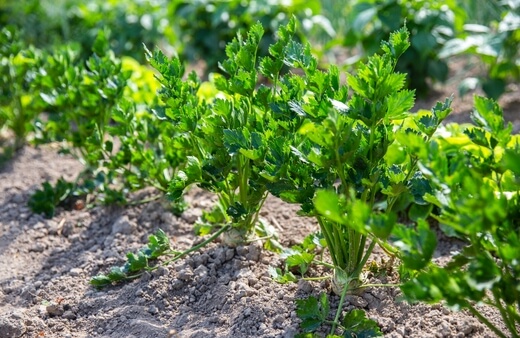
Parsley grows best in pots and containers but can cope equally well in well-drained raised beds, or even straight into garden soil with good preparation. Like all carrots, and members of the carrot family, parsley is really quite a hungry plant, so good nutrient levels are essential for successful outdoor parsley crops.
Soil & Drainage
Before planting parsley, enrich your soil, either with well-rotted manure or by digging through plenty of compost. If you’re growing in pots, you can use pure garden compost to grow parsley, but be sure to add some vermiculite or a few handfuls of garden sand to aid drainage.
In containers, make sure to add crocks to the base of the pot so water can escape. Parsley roots grow almost vertically down, despite being fibrous, so standing water can cause problems.
Watering Parsley Outdoors
Water parsley once or twice a week in summer and never let it dry out completely. Parsley responds quickly to watering and can put on up to an inch of growth per day.
NOTE: One important note here though, is that parsley might like good drainage, but it can cope with boggy conditions or even clay soil. Just before I began writing this, I noticed that one of last year’s plants was sitting in a pot with blocked drainage holes, and the internal plastic pot was literally floating in water. The parsley had re-sprouted and was growing just fine.
Light
Position your parsley pots, beds, or containers in full sun. If your garden has summer temperatures that stay regularly above 25C, consider providing some shade, but in most gardens, or patios, try to provide as much sun as possible for these Mediterranean herbs.
How to Grow Parsley Indoors
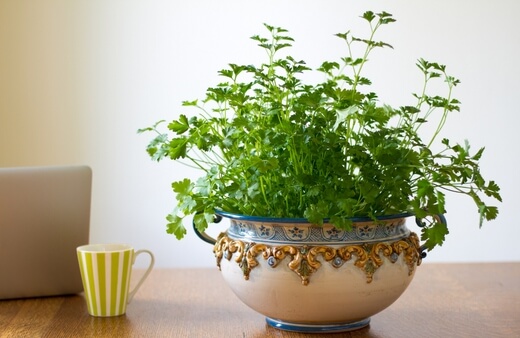
Growing Parsley indoors is even easier than growing it outdoors, but humidity control and ventilation are important. Parsley grown indoors tends to live shorter lives than parsley grown outdoors, so make sure it has good sun, a big enough pot to develop, and your plants aren’t too crammed in.
If you’ve ever bought a living parsley plant from the grocery store, and wondered why it doesn’t come back, just check how close they grow. Grocery store parsley is grown intensively, and each plant has about 1” of space around it, so by the time you cut it, there’s no goodness left in the soil to revive each plant.
Soil
Pure compost is fine for indoor parsley, with no extra drainage, grit or perlite added. This is simply because you have full control over your watering routine indoors, so excess rain isn’t a problem.
Watering Parsley Indoors
Tap water, once or twice a week is ideal for parsley plants grown indoors. Add some liquid fertiliser once a month to help revive the soil. If the soil is still damp from the last watering, move your parsley somewhere brighter to evaporate excess moisture.
Only water indoor parsley when the soil begins to dry out.
Indoor Light Requirement
Parsley needs full sun indoors, and won’t tolerate any shade. Keep your pots of parsley on a north-facing windowsill if possible. East or west-facing windows are ok, but slow down watering in this case, to prevent waterlogging.
Ventilation
Indoor grown parsley needs plenty of ventilation. Humid, damp environments (like kitchens) are the worst possible place to grow parsley, so keep windows open through summer, and use your extractor fan if you have one.
Humidity not only promotes fungal problems with leaves, it increases the risk of root rot and overwatering, and can attract pests.
How to Propagate Parsley
Before you can harvest parsley, and before you can even think about growing it, you'll need to get to grips with propagation. Thankfully, parsley is simple to propagate, and can grow from both seeds and cuttings.
Personally, I prefer to grow parsley from seed, but if you’re coming to the end of your crop, it can be quicker to root a few stems in water for a kick start while you wait for seeds to germinate.
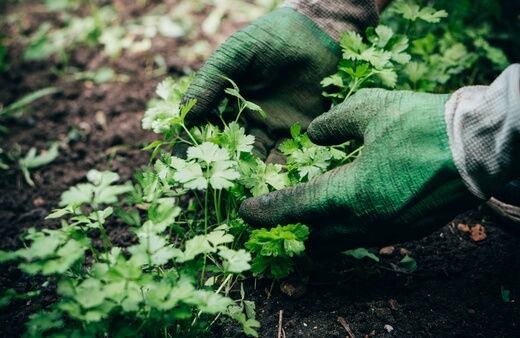
Propagating Parsley from Seeds
To grow parsley from seed, you’ll need a few basic bits of kit, a sunny windowsill, and a little bit of patience (it can be hard to resist those fresh young leaves when they come through!)
You will need:
- Any container with drainage holes (seed trays are perfect, but small pots work too)
- Garden soil, compost, or coir compost
- Parsley seeds
Method:
- Fill your container with whatever planting medium you choose.
- Water the soil until it is evenly moist.
- Sow parsley seeds 2” apart on the surface of the soil.
- Leave in a bright spot (over a radiator in winter, or in full sun through spring and summer).
- Water twice a week from the base, or whenever the soil begins to dry out).
- Prick out seedlings when they reach 5cm tall, into individual pots.
- Pinch out the top few leaves to encourage bushier growth.
Parsley Propagation from Cuttings
Most people don’t think of taking cuttings from soft herbs, as they are shorter-lived, but even through winter, parsley will grow from cuttings and can thrive indoors. In spring and summer, cuttings can be taken at any time and planted out as soon as they’ve rooted.
- Start with about five or six stems, cutting them as close to the soil as you can, while leaving plenty of stems on the original plant (use clean, sharp scissors, to avoid infection or bruising).
- Place the cuttings in 1-2” of tap water, and replace the water every 3-4 days.
- After a week, roots will appear. After two weeks, there should be a tangle of roots in the vase.
- Carefully place these cuttings in an empty pot, and fill dry soil around their roots, shaking and gently tamping the pot to prevent air pockets.
- Water the container from the base by standing it in water for 5-10 minutes.
- After another week, roots should appear at the base of the pot, and the top growth should be getting quite bushy. You can either keep these indoors or plant them into the garden.
Possible Problems When Growing Parsley
Parsley is incredibly attractive to slugs and snails, and most common carrot and celery pests too, so is far from pest free. However, the resilience and quick recovery time of these tough little herbs means that they suffer from fewer diseases than most, and can bounce back rapidly from a pest infestation.
Parsley Pests
Aphids, slugs and snails are all common parsley pests, with aphids being particularly prevalent all year round due to the soft growth of parsley through all seasons, providing a home for the small flies when most other herbaceous annuals and perennials have died back.
Thankfully, aphids, slugs and snails are all simple to control. Add egg shells (lightly crushed, so they are still sharp) as a mulch around the base of the plant. This adds calcium to the soil, and creates a surface that snails and slugs hate.
For the aphids, simply wash them off with a hose every so often, and try to encourage wasps and ladybirds into the garden as natural predators. Also, read our in-depth guide how to deal with aphid infestations.
The biggest problem for parsley is carrot root fly, which won’t affect your crop in the short term, but can kill plants. If you grow carrots, parsnips or celeriac, try to keep some distance between these crops to prevent the spread of carrot root fly, and don’t plant them in the same bed the following year.
Parsley Diseases
Parsley does suffer from root rot in exceptionally damp conditions, but we’ve found that even parsley grown in completely waterlogged soil can survive. Mildew and rust viruses are worse problems for parsley as it ruins its texture and makes it completely inedible.
If you notice any discolouration or mildew on parsley leaves, cut away the damaged foliage and bin it.
Parsley Frequently Asked Questions
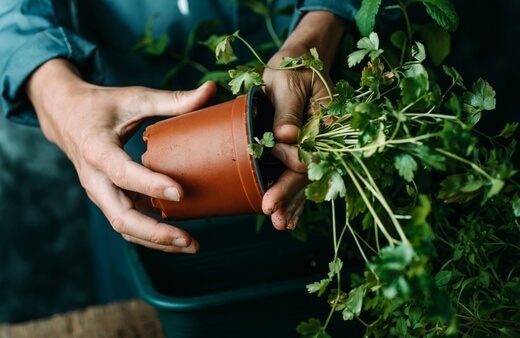
Does parsley come back every year?
Parsley can come back year after year with proper care. While parsley will die back after setting seed, it will easily self-seed in its pot or container, and re-sprout next spring.
Some varieties of parsley are also perennial, like Hamburg parsley, which has a harvestable root in the first year, and a tough woody root, which will regrow foliage every year after that if left unpicked.
Will parsley grow back after cutting?
Parsley will grow back after cutting and will produce more and more parsley as a result. At the seedling stage, it’s a good idea to cut parsley back to the lowest leaves to encourage a bushier plant.
As you harvest, try to do it carefully, so cut back to a leaf node each time, leaving the potential for fresh growth.
Does parsley grow in shade?
Parsley can grow in part shade, but does much better in full sun. The more light you give parsley, the faster it grows, and the better its soil conditions will stay. If you’re worried about overexposing parsley to wind and rain, provide some dappled shade from the elements, but aim for at least 6 hours of direct sun per day.
Does parsley grow better in pots or the ground?
Parsley will grow faster and stronger in free-draining soil in the ground, with regular irrigation, but in most homes, is much easier to grow in pots and containers where you have full control over watering and irrigation to prevent the possibility of root rot.
What should not be planted near parsley?
Avoid planting carrots, parsnips, celery or celeriac near parsley. They are all part of the same family and share the same pests and diseases. And despite the overall benefit of growing alliums near carrots and parsley (they help to prevent aphids and most common pests) they also have chemicals which will stunt the growth of parsley, so don’t make good companion plants.
Are coffee grounds good for parsley plants?
Coffee grounds are only suitable for parsley if the soil is particularly alkaline as they acidify the soil and have little other benefit. Use other kitchen waste as mulches for parsley, like banana tea or egg shells.
Does parsley need a lot of water?
Parsley plants need a lot of water through summer to keep them growing actively. While parsley needs good drainage that does not mean it can cope with drought. Drainage merely prevents waterlogging.
Every time you water parsley, water it generously, and then leave it to use that water completely before watering again. In most of Australia that means watering once or twice a week in summer.
Should you let parsley flower?
Flowering parsley, depending on the species, can mean the end of your plant. You can either let it go to seed and self-seed around the garden for fresh plants later in the year (or next year) or deadhead the flowers right back to non-flowering growth, to extend its life.
How long will a parsley plant live?
Flat leaf and curly leaf parsley typically live for two years. Once they flower, they set seed and will die back. The seeds left behind will usually re-sprout in spring with reasonable irrigation.
How do you pick parsley so it keeps growing?
Always cut parsley near the base of a stem, but just above the lowest leaf or leaf node. Cutting parsley at the top will encourage fungal problems, and stunt growth. Cutting near the base triggers fresh growth, and a prolonged harvest.
Can you leave parsley outside in winter?
All types of parsley are frost hardy, and will survive through heavy snow and frost. Prolonged late winter or spring frosts can limit growth in parsley’s second year though, so if you can, protect plants from frost with fleece, or by bringing them inside or into greenhouses.
Can parsley be planted close together?
Parsley should not be planted too close together, and overcrowding parsley in containers will limit the growth of the plant, and its life span, often causing a failure to resprout after cutting.
Plant parsley seeds at a minimum of 2” apart, and thin to 3-4” apart when they reach 5-10 cm tall.
Wrapping Up Our Parsley Growing Guide
Despite a few minor challenges, parsley really is easy to grow at home. All you need is reasonably good drainage and plenty of goodness in your soil. If you can provide that, and keep them pest free, you’ll have enough parsley to feed the family all year round.
If you’ve never grown parsley before, or you’re trying to get kids into gardening, growing soft herbs like parsley and coriander is a great place to start!
Published on January 30, 2023 by Maisie Blevins
Last Updated on February 22, 2024





